What is the difference between LED and OLED TVs
It’s hard to imagine that even 20 years ago many people admired a color kinescope TV, and today they are choosing between LED and OLED technologies. Finding the right model for a modern TV device that matches its financial capabilities is not so easy today. The choice also complicates the marketing direction of manufacturers, each of which promotes their own direction. These two technologies that are alike in name often have significant price difference. Therefore, it is important to clearly understand the advantages and disadvantages of modern LED and OLED TVs, what is their similarity and fundamental difference.
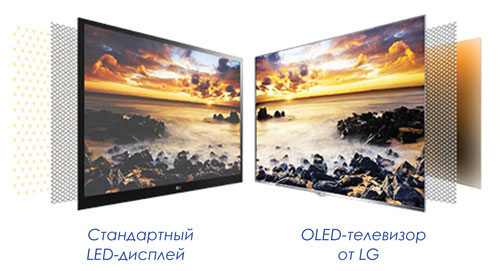
Content
Features of LED TVs
LED literally stands for “LED”.Most modern models of such TVs are based on the LCD matrix. But unlike its predecessors LCD Tv, in which sources of luminescence were used CCFL lamps, these devices use more modern and fade-resistant LEDs.
Despite all the differences and the use of different types of illumination, the principle of operation for LED models is the same. Speaking about how they are arranged, you can visually imagine a large number of arrays equipped with various LEDs. Further, all LEDs are passed through a special filter, and depending on the voltage of the electric current become either brighter, or vice versa, the light is blocked. Such a design makes it possible to form a clear image in accordance with the specified settings. Repairing such an illumination is a painstaking task, but it can be done. do it yourself.
Depending on the cost of the model, a different kind of backlight is applied:
- It can be located across the entire screen area - matrix (Direct LED), which improves image quality, but increases panel thickness and power consumption;
- either on one, two sides or around the perimeter of the screen (Edge LED).
Speaking of the second version, it can be noted that the image is inferior in quality to the first type, but due to the location of the backlight, the thickness of such panels can be less than 1 centimeter, it is also much cheaper and more energy efficient. All the nuances of these TVs can be found in the article about LED TV selection.

LED TV device with matrix illumination
Features OLED-TVs
The principal difference between these devices is the use of organic light-emitting diodes as a backlight. The basis of such devices is a three-layer structure, one of the parts of which is a special film with pixels, each equipped with an individual self-emitting LED (structures Rgb or WRGB).
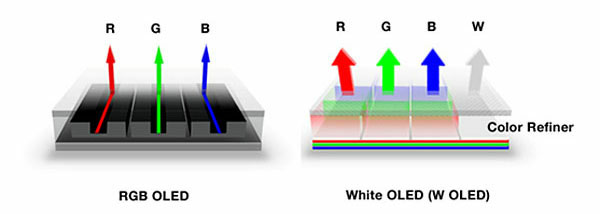
Speaking of the LED-model, all the necessary effects of illumination or dimming are created by turning on or off the required number of LEDs. Depending on what function should be performed, the luminous flux from the LEDs can be increased or blocked. In addition, there is additional filtering to make the image clearer.
The situation is completely different with OLED (Organic Light-Emitting Diode) models - they do not need to filter light.In this case, the current is conducted through several millions of individual LEDs, whose size does not exceed one pixel. They are created from a special polymer material, so they can include the function of radiation or darkening.
Due to its size, organic light emitting diodes They are not used as a supplement to the LCD matrix, but are its structural part. They are able to independently highlight each pixel of the TV screen and do not require additional illumination. Therefore, such models have a smaller thickness, weight, differ in high-quality color and contrast.
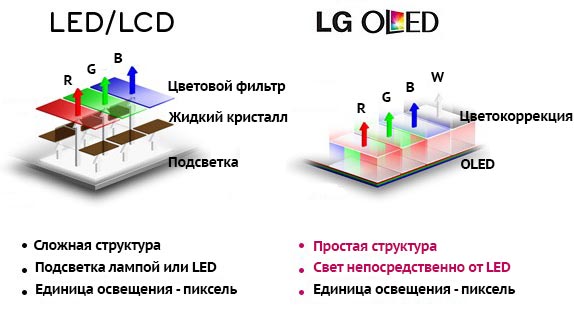
Initially, this technology began to be used in the mobile gadget industry, whose display size is much smaller. But today it is successfully used for widescreen television equipment. While the development and release of OLED panels are engaged only in leading manufacturers: Sony, LG and Samsung. So, new series of OLED TVs Sony Bravia was presented at CES-2017.
Due to its structure, such TVs can have not only a standard flat shape, but also a concave one.
What is the difference between LED and OLED models of modern TVs?
These types of devices should be compared separately for each item.
Color rendition
Immediately it should be said that the color quality is at the height of both technologies. Here they will differ little. However, speaking of LED TV, it can be noted that they are inferior in such characteristics as realistic. OLED uses more wide range of colorswhich the human eye is capable of accepting. This effect is due to the fact that in the second version there are LEDs of all natural colors, which is not always in the LED.
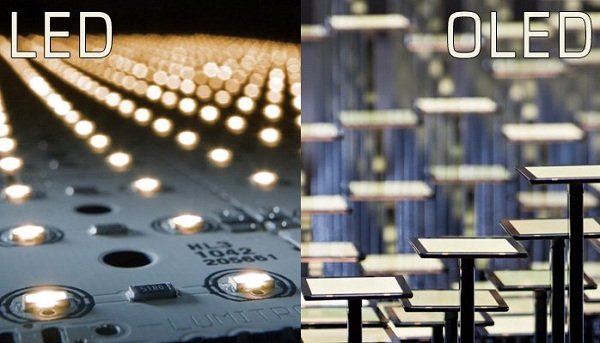
Brightness
Not much here, but the LED wins. As a rule, this technology copes with the function full screen lighting. While OLED lighting boasts perfect lighting, most often, only a specific area. Regularly turning on the diode on the mode of intense brightness reduces its service life and increases the return time to black mode. Therefore, such screens are not recommended to use constantly at maximum brightness settings.
Contrast and black level
Speaking about the OLED model, one can say with precision that there is not a single TV model that could surpass it. black content. LED devices use LED backlight LCD panel. But even applying the technology of blackout diodes, it is impossible to surpass the reproduction of dark black in OLED. And the ability of the screen to maintain perfect black color is one of the fundamental factors that is responsible for the image quality.
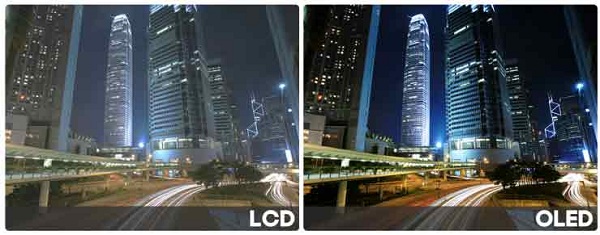
Viewing angle
There are also no equal OLED models. This advantage is achieved due to the absence of an additional layer between the backlight and the screen. Therefore, bright spots or other possible deformations of the image are excluded.
Resolution
Comparing by this criterion, there is no winner. Since both technologies today have common maximum resolution parameters with the same number of pixels of 3840 x 2160 (for more, read the article about TV resolution).
Response time
Despite the fact that LED technologies are constantly being improved, organic LEDs are undoubtedly the leaders among all television technologies that exist today. This criterion allows avoid image blur when driving and artifacts on the TV screen.
power usage
The most profitable in this board are LED-TVs with side illumination. OLED technology is currently losing, although developers are planning to bring organic LEDs closer to LEDs. If you do not know how much TV can consume at all, read how to find out the power consumption of your TV.
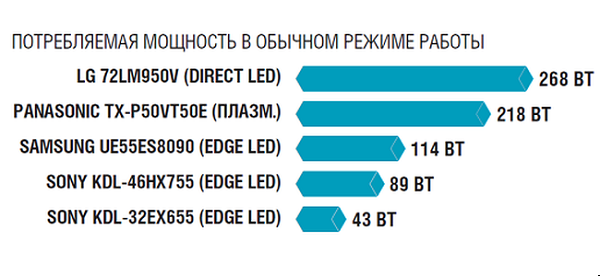
Cost of
In many respects, OLED technology indicators exceed LED, so their cost is slightly higher. But this does not mean that it can not cause any problems. In fact, such models can seriously compete with LCD versions of the “Premium” class, since not every family has the opportunity to keep up with new technically advanced models.
Some manufacturers have set a goal for themselves to reduce the cost of their own offers and make OLED TVs more affordable.
Summarize
Having considered the differences LED and OLED, we can conclude that, of course, organic LEDs benefit from many technical characteristics. But today it is impossible to call such an option oriented to the average population, because absolutely not every person will be ready to pay a “tidy sum” for a novelty, which in a few months will not be such.Regarding other issues, OLED is the technology of the future, which, after the necessary improvements, will push the use of LED TVs to the background.

/rating_off.png)












